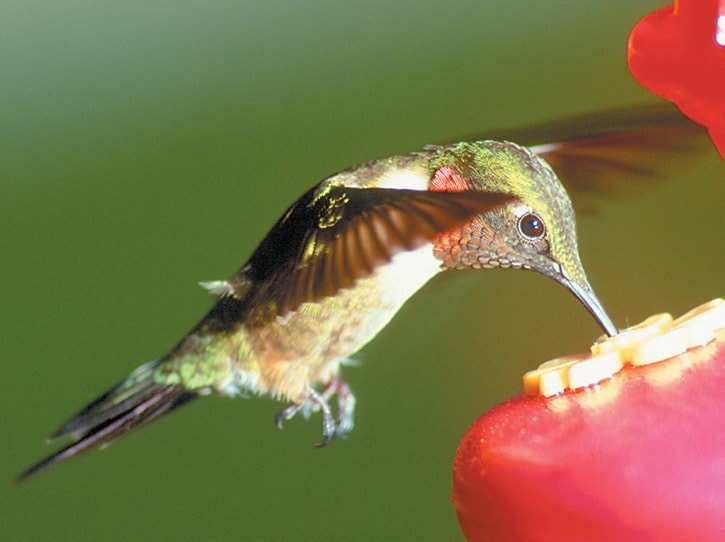By Rick Stiebel
Gram for tiny gram, hummingbirds have to be the toughest little critters on the planet.
Any creature small enough to fit in the palm of your hand that weighs less than a penny and can handle a 20-hour, non-stop 800 kilometre flight across the Gulf of Mexico deserves a lofty perch atop the animal wingdom.
My first encounter with the magical miniscules occurred during a summer vacation on Quebec’s majestic Lake Memphremagog when I was six or seven years of age.
I was absorbed in a comic book when an iridescent flicker buzzed by my ear out of nowhere to feed on a potted plant less than a foot from where I was sitting.
The sound of those little wings whirring away between sips was almost as impressive as its lightning quick departure in reverse, the only bird that can pull off that backwards manoeuvre.
We’re blessed in Sooke to live in an area where a number of the 338 species of hummingbirds thrive year-round.
A feeder by our kitchen window and another on the back deck affords a variety of views that lets us watch them fight over seating from dawn until dusk, including in weather stormy enough to blow the hat off your head. It’s always an amazing sight that guarantees an admiring smile on our faces, whatever mood we’re in.
My wife has even taken to naming them based on their personality traits; meet Sippy, Big Gulp, Flitty and Gazy.
Although I am guilty of the occasional grumble and have been known to beak off about our sugar bill when I have to do a cleaning and refill after they tear through both feeders in a couple of days, we won’t go to bed before ensuring there’s enough liquid in each one to get our feathered family through the morning rush hour.
Joan even insists on bringing the feeders in when the temperature drops to freezing. Fortunately, that only happens in the winter when it’s still dark before she gets up, or she would probably set her alarm so she wasn’t late with their breakfast. Apparently, it’s their most important meal of the day, next to lunch, dinner and all day snacks.
We add the new batches of nectar only after it’s dark. It can be a little unsettling if you interrupt their approach and they have to silently screech to a halt if your movements startle them on their approach to the buffet.
You don’t want to get on their bad side because they can live up to 10 years and may decide decide to drop you from their route if there’s better service down the road.
They prefer it if you boil the water first – four parts of H2O to one part sugar – and let it cool completely after dissolving the sugar.
A naturalist at Goldstream Provincial Park told me that’s the right recipe, and much better for them than the mysterious liquid of unknown origin sold in stores. Using a surgically sterilized whisk is optional, but a nice touch nonetheless.
The feeder’s bright colours attracts them, so there’s no need for artificial colouring. It’s best to place your feeders near flowers so the mighty mites have a variety of drive through and fast food options.
•••
Rick Stiebel is a Sooke resident and semi-retired journalist.
